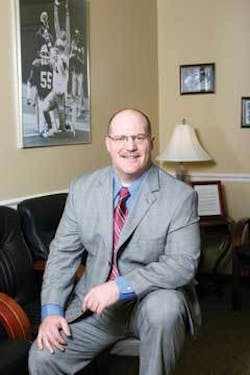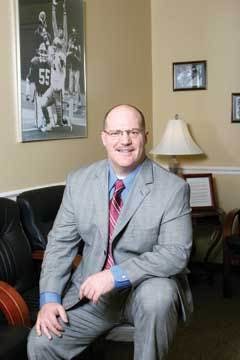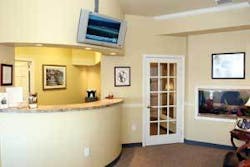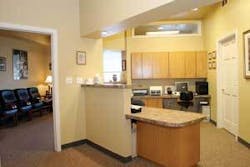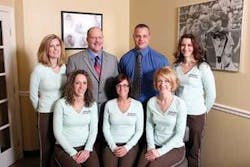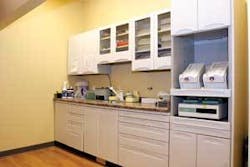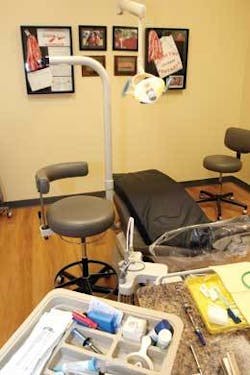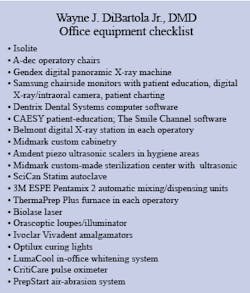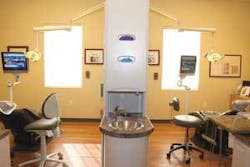Never say never
Dr. Wayne DiBartola Jr. defies label of being “too small and not smart enough” as a youngster to play major college football before developing a flourishing sedation dentistry practice in his home state of Pennsylvania.
Growing up, Dr. Wayne J. DiBartola Jr. was once told that he was too small to play Division I college football and not smart enough to be a dentist.
Not to be denied, Dr. DiBartola went on to become a three-time football letterwinner at the University of Pittsburgh, helping the nationally ranked Panthers compile a 33-3 record during his playing days.
Following graduation from dental school, he opened an office in the Pittsburgh suburb of Bridgeville. After concentrating his efforts for 17 years in general dentistry, the Pennsylvania native decided to take on the challenge of adding sedation dentistry to his practice’s treatment offerings.
Since then, Dr. DiBartola’s patient volume has blossomed to the point that - in August 2005 - he moved into a new five-operatory, 2,200-square-foot facility in Bridgeville.
Yes, for Dr. DiBartola, “never” has never been part of his life’s “playbook.”
Whether it has been on the football gridiron or in the dentist’s chair, Dr. DiBartola has not been afraid to tackle whatever goals he has established in life.
“My mom and dad raised me to believe that if I wanted to do something, then I should pursue it,” said the dentist, who is a father to five young children.
Setting and attaining goals began at a young age for a then aspiring dentist, who was advised by a middle school guidance counselor not to follow his dreams of playing collegiate football or seeking a career in dentistry.
Academically, one of his high school objectives was to be named to the National Honor Society. After a concerted effort to improve his grades in order to qualify for the NHS, he achieved that goal. Then, during his final year of high school, he secured an appointment to the U.S. Naval Academy to play football for the Midshipmen and to continue his education and pursuit of a dental degree.
“I was going to attend the Naval Academy but, during my senior year, the school decided to drop its dental program,” Dr. DiBartola recalled.
So, on national football signing day in February 1977, he opted to attend the University of Pittsburgh instead.
“The University of Pittsburgh’s recruiter was at my high school on signing day,” he said. “Pittsburgh had just won the national football championship in 1976, and I had heard about the university’s dental school. So, for me, I thought it was the best of both worlds.”
While Dr. DiBartola’s 5-foot-11-inch, 215-pound stature might have been sufficient as a fullback at the high school level, he quickly learned that he was small for that position in the college game.
“Back then, the standard size for a college fullback was in the 6-foot-1-inch, 230-pound range,” he said.
Nevertheless, he persevered with his football dream, overcoming any deficit in size with his burning desire to outwork people. As a reserve, he lettered his first two years (1979, 1980) as the Panthers fashioned 11-1 marks each season.
“It’s funny. I had been told my whole life that I was too small to play. Then, when I did get a chance to play, I was told that I was too slow. So I had a really difficult road just to get on the football field,” he said.
Dr. DiBartola’s determination resulted in his being named the team’s starting fullback in 1981. Pittsburgh’s quarterback that year was a freshman named Dan Marino, who later became one of professional football’s most prolific passers.
Pittsburgh spent four weeks as the nation’s No. 1 team in the 1981 season until a loss to rival Penn State in the regular season finale ended the team’s hopes for a national title. The Panthers rebounded, however, to rally for a 24-20 triumph against defending national champion Georgia in the 1982 Sugar Bowl to finish fourth in the final Associated Press rankings.
“That year, we were not supposed to be very good,” he said. “But we were the top team in the country for several weeks. Following the disappointing loss to Penn State, we overcame several obstacles to defeat a Georgia squad that featured a future Heisman Trophy winner in running back Herschel Walker.”
During his final season of football eligibility, Dr. DiBartola also began his first year of dental school. He readily admits that what he learned while on the gridiron carried over to his time in dental school as well as to his future career in dentistry.
“The work habits that I had while playing football helped me get through dental school,” said the dentist, who turned down National Football League free agent contract offers with the Philadelphia Eagles and Pittsburgh Steelers in order to continue pursuit of his dental degree.
“I had my ups and downs but never gave up. I would just work harder, get up earlier, or do whatever it took to be successful. Playing football, particularly doing so the hard way by working for everything that I achieved, has really helped me in the business world.”
Following graduation from dental school with his DMD in 1985, he opened a practice in Bridgeville (about a 15-minute drive from downtown Pittsburgh) with just one staff member and one operatory.
“It was scary. I didn’t know anyone in the town, and I had no patients,” the dentist said. “At the time, I couldn’t afford a big, plush office.”
Much like during his college football playing days, Dr. DiBartola relied on a strong work ethic to build his starter practice.
“We would work from 7 a.m. to 7 p.m. six days a week,” he said. “They were hard hours. But I needed to be there. My philosophy was that if I put my nose to the ground and worked hard, then I would be successful.”
That philosophy proved to be a winning one. As the number of patients grew steadily, two additional treatment rooms had to be created from existing space in the 1,200-square-foot facility. But, even after 17 years of experiencing success, Dr. DiBartola sensed a change was necessary.
“We had become a ‘flat’ practice. We reached a point in which our numbers began staying the same,” he said.
So, in 2002, he attended a Whitehall Management seminar, which was led by Greg Stanley. At the seminar, the Bridgeville dentist decided to begin offering sedation dentistry as a niche to his practice.
“I thought sedation was the proper way to go,” he said. “Greg guided me through the process. His direction has helped my practice numbers to increase.”
Another influential person for the Bridgeville dentist has been Dr. Joe Blaes. Dr. DiBartola met the editor of Dental Economics® during one of Dr. Blaes’ “Veneers Made Easy” seminars in St. Louis.
“I went to the seminar wanting to improve my veneer technique,” Dr. DiBartola said. “In addition to helping me clinically, Dr. Blaes taught me a lot, in general, about dentistry. He was a very good source of information for me. He also introduced me to my extraordinary lab partner, David Block, owner of Aesthetic Porcelain Studios.”
Armed with this information and with the introduction of conscious sedation dentistry, the Bridgeville dentist’s practice volume escalated. Before long, it became apparent that a larger home for his practice was necessary.
So Dr. DiBartola took part in the design of a new facility. Located just a half mile from his first office, the new building - which opened its doors last August - provides nearly 1,000 more square feet of space in which to work.
The additional square footage, which includes rooms for consultation and diagnosis, allows ample space for treatment by sedation. Foremost among the equipment used with sedation patients is the Isolite.
Initally learning about the product in the pages of Dental Economics, Dr. DiBartola and his staff have worked with the Isolite the last five months.
“Of all the equipment that I have used, this is the one item that I think every dentist should have,” he said. “I know it has made my sedation dentistry treatment much more reasonable.”
Besides being easy to learn to operate while significantly reducing the time spent on procedures, the Bridgeville dentist calls the Isolite “patient-friendly” and much safer than working with rubber dams in a patient’s mouth.
“Assistants like the unit because it isolates, suctions, and lights the area in which you are treating,” he said, noting the unit also would work well for quadrant dentistry or hygienists who work by themselves.
Dr. DiBartola’s numbers have surged since his introduction of conscious sedation. With this technique, patients take a small pill that creates a relaxed feeling. While in this state of relaxation, patients receive treatment, thus relieving anxiety for those people who might be hesitant about dental care.
“The technique is a good one for those people who have a fear of dentists,” he said.
But Dr. DiBartola knows he cannot expect continued success based merely on the relative uniqueness of sedation dentistry. After all, with some 20 dentists gracing the scene in the community of Bridgeville (estimated population of 5,000), there is quite a battle for the dental dollar.
So, once again, much like his football days at the University of Pittsburgh, Dr. DiBartola knows that he must continue to persevere to set himself apart so he can “carry the ball” and remain one step in front of the onrushing competition.
“Sedation dentistry is a real challenge. It’s a challenge to provide that type of treatment for a patient,” he said. “Sedation is a niche that not everyone wants to do. There is a huge learning curve so that you can perform the technique the right way. It’s hard work.”
But, for Dr. Wayne DiBartola, that extra effort in life is nothing new for someone who makes it a point to never say never.
